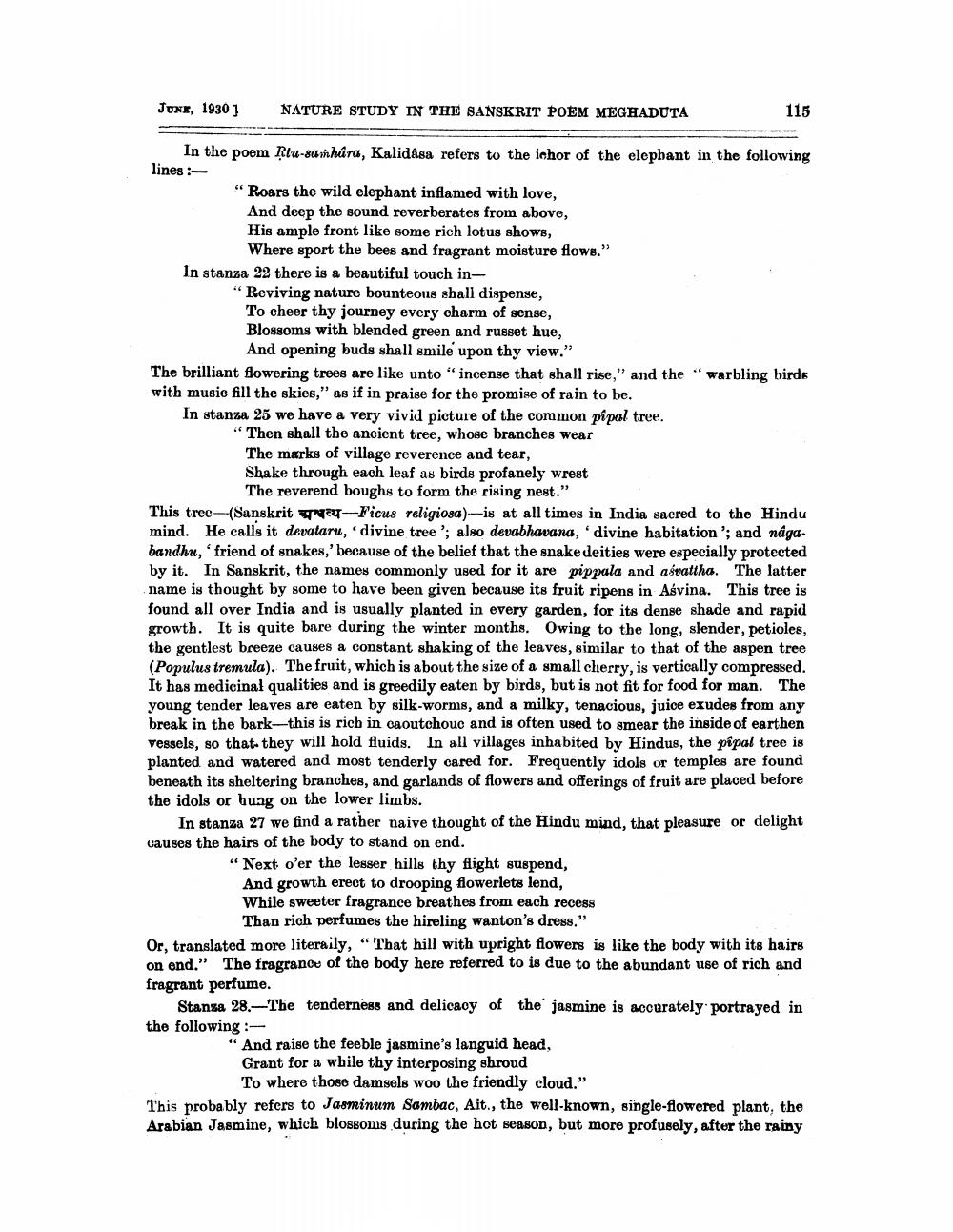________________
JUNE, 1930)
NATURE STUDY IN THE SANSKRIT POEM MEGHADUTA
115
In the poem Řtu-samnhára, Kalidasa refers to the ichor of the elephant in the following lines ?
“Roars the wild elephant inflamed with love,
And deep the sound reverberates from above, His ample front like some rich lotus shows,
Where sport the bees and fragrant moisture flows." In stanza 22 there is a beautiful touch in
"Reviving nature bounteous shall dispense,
To cheer thy journey every charm of sense, Blossoms with blended green and russet hue,
And opening buds shall smile upon thy view." The brilliant flowering trees are like unto “incense that shall rise," and the "warbling birds with music fill the skies," as if in praise for the promise of rain to be. In stanza 25 we have a very vivid picture of the common pipal tree.
“Then shall the ancient tree, whose branches wear
The marks of village reverence and tear, Shake through each leaf as birds profanely wrest
The reverend boughs to form the rising nest." This trec-(Sanskrit Ficus religiosa)-is at all times in India sacred to the Hindu mind. He calls it devalaru, divine tree'; also devabhavana, divine habitation '; and nagabandhu friend of snakes,' because of the belief that the snake deities were especially protected by it. In Sanskrit, the names commonly used for it are pippala and asvattha. The latter name is thought by some to have been given because its fruit ripens in Asvina. This tree is found all over India and is usually planted in every garden, for its dense shade and rapid growth. It is quite bare during the winter months. Owing to the long, slender, petioles, the gentlest breeze causes a constant shaking of the leaves, similar to that of the aspen tree (Populus tremula). The fruit, which is about the size of a small cherry, is vertically compressed. It has medicinal qualities and is greedily eaten by birds, but is not fit for food for man. The young tender leaves are eaten by silk-worms, and a milky, tenacious, juice exudes from any break in the bark--this is rich in caoutchouc and is often used to smear the inside of earthen Vessels, so that they will hold fluids. In all villages inhabited by Hindus, the pipal tree is planted and watered and most tenderly cared for. Frequently idols or temples are found beneath its sheltering branches, and garlands of flowers and offerings of fruit are placed before the idols or hung on the lower limbs.
In stanza 27 we find a rather naive thought of the Hindu mind, that pleasure or delight vauses the hairs of the body to stand on end.
“Next o'er the lesser hills thy flight suspend,
And growth erect to drooping flowerlets lend, While sweeter fragrance breathes from each recess
Than rich perfumes the hireling wanton's dress." Or, translated more literaily, “That hill with upright flowers is like the body with its hairs on end." The fragranou of the body here referred to is due to the abundant use of rich and fragrant perfume.
Stanza 28.-The tenderness and delicacy of the jasmine is accurately portrayed in the following:
"And raise the feeble jasmine's languid head, Grant for a while thy interposing shroud
To where those damsels woo the friendly cloud." This probably refers to Jasminum Sambac, Ait., the well-known, single-flowered plant, the Arabian Jasmine, which blossoms during the hot season, but more profusely, after the rainy




